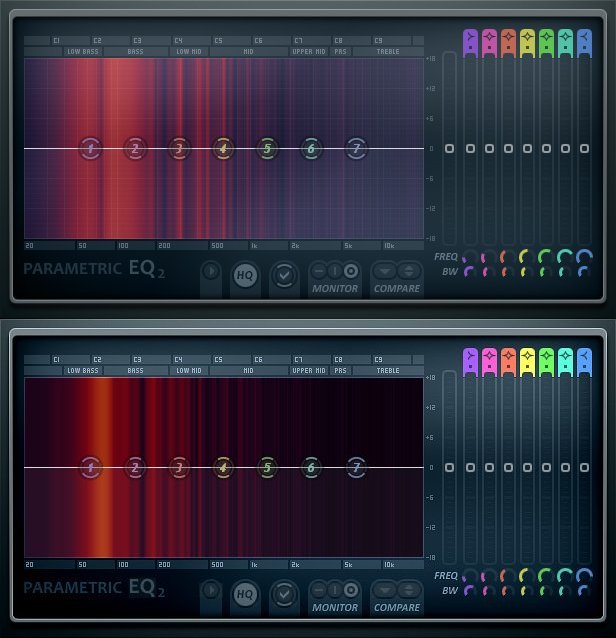Audio 'quality' is a little subjective. When we upsample filters we are doing so to reduce frequency warping at the high end of the spectrum.The above shows the difference between an analogue filter and a digital filter using the bilinear transform. Observe that whilst the analogue filter continues beyond our sampling frequency, the digital filter is locked down at Nyquist (we can presume from the diagram this system is functioning at a sample rate of 2kHz).Consider movement of the analogue filter. It's curve will be more or less fixed and is not subject to a sample rate; whereas the digital filter will always be zero at the 'Nyquist frequency' or half the sampling rate. Therefore, if our Nyquist frequency is within audible range, we would be able to hear this effect.This doesn't apply to all digital filters but the filters in PEQ2 are from the Cookbook and therefore are subject to this condition.So, you have a choice: You can oversample the whole system and run plugins without upsampling to reduce frequency warping, only upsample individual plugins or try both.
Fl Parametric Eq 2 Presets

There will be an optimum point, however. Once you're running at about 96kHz, frequency warping is so far out of the range of human hearing that it is less likely to be potentially problematic.Some might say it's only a problem if you want it to be and make do with compromise. It can potentially introduce phase issues but I don't think this is a major issue.
In a very quick way, I doubt you'd notice the difference between HQ and non HQ with PEQ2 especially if you aren't dealing with anything near Nyquist. Really, the HQ is just some oversampling to mitigate the issues with running filters around Nyquist which for a 44,100Hz system is 22,050Hz. The why for this is a bit complicated on a technical level, but really it just boils down to the fact that mathematically things don't work out when you start to go above half the sample rate. Something UA didn't mention is that if there are any components above Nyquist that they'll actually get reflected back down into the audible spectrum.
Part of the reason for high sample rates actually has to do with interfacing with the analog world as the reflected sounds are directly related to how high they are above Nyquist. But this is going to quickly go completely off topic.Another thing to note about the HQ mode with PEQ2 is it actually introduces latency that isn't reported which can cause phase issues. See the attached FLP for an example. Basically, I have the same file with one phase inverted so they cancel each other out completely.

I have HQ mode enabled with PEQ2 already. Turn off HQ mode and you won't hear anything. Just a heads up if you're doing any parallel processing that is phase dependent.-APZX. I don't care if it incurs latency.
What I care about is that latency gets reported to the DAW so that it may be compensated for. PEQ2 has had this issue ever since it was introduced which has been what since like FL 7 or 8? We're several versions past that and they haven't bothered to fix it.Strange how that mirroring works isn't it?
Some of this stuff is truly awesome to explore. I know that suggests an ideal sampling rate of something like 60-ishKHz. But he does say that 88.2KHz or 96KHz are more ideal as they are reasonably close. These do away with several of the issues creating a linear passband, and mitigate issues encountered with the analog world while still providing good accuracy.-APZX.

I would agree with that. I can't find them right now - I performed a search earlier - but I did once come across a graph which compared frequency warping at different sampling frequencies and it was clear that most 'natural' results were around 96kHz (it only detailed common SF).It is odd that FL Studio doesn't report the latency in PEQ2. I'm sure I've come across a few third party plugins like that. You only really get to hear it when running in parallel.
Of course, running most filters in parallel isn't usually wise - with the exception of allpass filters, which perform magic in parallel. Yeah I mean I kept PEQ2 flat in terms of doing anything so there is no phase shift happening from the filters. It is purely just PEQ2 not reporting its latency to FL. Granted in most situations this isn't a big deal, but it certainly could. Sometimes the inherent phase shift caused by a filter when used in parallel is desirable, but if the plugin itself is causing a delay that isn't compensated for then you're kind SOL.
I guess it is what it is, but really if you're not using PEQ2 in the really high freqs not being in HQ mode isn't that big of a deal.-APZX. The only thing I dislike about the filters in FL Studio is that the interface doesn't relate to their internal design. I'm speaking specifically about Q.
Behringer Parametric Eq
I don't know what kind of range they chose to represent between 0 and 1 but Q values go well beyond 1 - as do these filters. However, they don't tell you what the Q actually is.For example. If I want to approximate a Butterworth filter using the Cookbook, I know that the Q value should be 0.707. If you put that into FL Studio, you're well into the realms of resonance; not the smooth roll-off one might expect from a Butterworth. It makes the Linkwitz-Riley configuration only possible through a plugin like the multiband compressor or by obtaining a third party filter which reports actual Q values and permits their input or a specific Linkwitz-Riley filter.